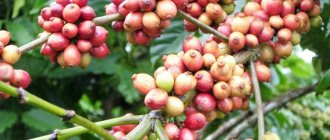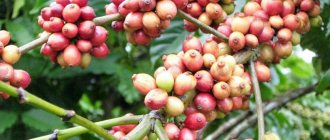Italy is the European gateway to coffee; aromatic beans appeared here in the 16th century thanks to Venetian merchants trading with the Ottoman Empire. Surviving correspondence and documents from the second half of the 16th century confirm that the strong tonic drink quickly gained popularity in the Italian city-states, although at that time it was more used as a medicine to improve digestion.
However, not everything was so smooth. The new drink was opposed, firstly, by wine merchants, fearing a decline in sales, and secondly, by Catholic priests and parishioners, emphasizing the Muslim origin of coffee. In 1600, indignant Venetians sent Pope Clement VIII a request to ban the devil's drink. The pope, having tasted a cup of coffee, found it tasty and refreshing, so the pontiff simply blessed the grains, expelling the “devil” from them, and did not satisfy the request of the townspeople.
Pope Clement VIII approved coffee for Christians
Considering that Clement VIII sent Giordano Bruno to the stake, modern researchers never tire of being surprised by this Pope’s loyalty to coffee.
In the middle of the 17th century, coffee was sold throughout Italy - it was carried by traveling merchants along with lemonade and alcohol. In 1683, the first coffee shop opened in Venice, and by 1763 there were already 218 of them.
In 1884, an event occurred that forever changed the history and culture of coffee - Turin resident Angelo Moriondo invented the coffee machine, that is, in fact, became the father of espresso. The first models were powered by steam, but over time the device was improved and an electric version appeared in 1901.
The modern coffee machine was developed in the 1940s - it brews espresso from freshly ground coffee in just 30 seconds and pours it into individual cups (rather than pouring it into a common tank, as in the 19th century).
Coffee growing area
Coffee is a whimsical plant. It reacts negatively to any drop in temperature that is not related to seasonality. It is especially afraid of frosts, from which it can completely die. Before we talk about where coffee grows, we can talk about the varieties. There are three main varieties of coffee - Arabica, Liberica and Robusta. They are grown on an industrial scale for the food industry. Liberica is also used to obtain caffeine, as it is very rich in it. Arabica is a medium-sized shrub, and liberica is already a full-fledged tree.
But all coffee varieties love warmth and moisture, so they grow only in the tropics. Altitude is also an important factor in successful cultivation. The best altitude is considered to be from 600 to 1200 meters above sea level. The growing area is determined by the equatorial zone.
Only near the equator, where it is consistently warm all year round, there is a lot of precipitation and there are no sub-zero temperatures, can capricious coffee grow. This is the area between 10 degrees south latitude and 10 degrees north latitude.
Coffee from Brazil is the most abundant
In which countries does Arabica grow as the most popular and aromatic product?
coffee berry
- South American countries such as Colombia, Brazil, Peru.
- Central American countries: Mexico, Guatemala, Honduras.
- Countries of the African continent, such as Ethiopia, Cote d'Ivoire, Uganda.
- Asia: India, Indonesia, Vietnam.
Ethiopia is considered the birthplace of the coffee tree; it was there that the tonic properties of red berries were first noticed, which were used first as food and later to make a black drink. It was from Africa that the seeds came to other countries with a similar climate, where they successfully took root and began to produce crops. Brazil has the largest share in the coffee market. It supplies about 30% of the grain, mainly Arabica varieties.
Italy is considered the largest producer of coffee as a drink. Therefore, the legitimate question is, does coffee grow in Italy? Despite the long warm season, the climate of this country is not suitable for these plants.
History of coffee: myths and legends
There are many legends about the origin of the aromatic drink.
The most famous of them comes from Yemen, where, as the myth goes, the monks of the secluded monastery of Shekhodet, having learned from a shepherd named Kaldi that his goats and camels were cheerful even at night after eating certain berries, decided to go collecting miraculous fruits and make a drink from them in order to pray longer, forgetting about fatigue.
A lesser-known legend tells of the almost divine origin of the coffee drink. The Arabs say that one day the Prophet Muhammad felt very bad. Archangel Gabriel came to his aid and presented him with a potion directly sent by Allah. The drink was dark, like the Sacred Black Stone of Mecca, which is usually called "qawa" (kava). Mohammed drank the drink and felt an unprecedented surge of strength.
Another ancient legend, which was first told to the world by Antonio Fausto Nairone, professor of theology at the Sorbonne in 1700, tells that an Arabian shepherd named Cuddy, having brought his goats to pasture, was shocked that the animals, having eaten unknown berries, showed signs of strong excitement. The shepherd told about this to the old pastor Yahya, who, realizing that the excitement in animals was caused by the special properties of the plant, created a bitter drink that warmed the body to charge it with energy, relieving it of sleep and fatigue.
Another myth tells that a huge fire that spread across the vast territory of Abyssinia, covered with coffee trees, “roasted” the fruits, which emitted a special aroma that attracted people.
In general, there are simply countless legends about the origin of coffee. Researchers, however, agree on one assumption: the coffee drink was probably first prepared by the inhabitants of the highlands of Abyssinia. However, many travelers testify that coffee drinking was common throughout the Muslim East at the end of the sixteenth century.
Coffee came to the West through Venice, where the first “Coffee House” is believed to have been opened in 1640 (although some believe that a similar establishment was opened earlier in Livorno). In any case, the success was immediate and coffee became popular in every Italian city. They sold it in pharmacies, and it cost fabulous money. Just 13 years later, there were already 218 coffee bars in the city on the water. Even the Catholic Church, represented by Pope Clementius VIII, reacted positively to coffee.
Coffee break in Venice
In 1690, a team of Dutch sailors landed on the coast of Moka, in Yemen, and took possession of some plants: a few years later, the first plantations flourished in Java and Sumatra. Coffee later spread throughout Central and South America, where, especially in Brazil, the world's major plantations are now located.
How coffee is grown
Coffee is an evergreen plant that can bloom and bear fruit all year round. That is why it needs a constant flow of sunlight, moisture and heat. The most demanding coffee tree is considered to be Arabica and most of its species from Brazilian Santos and Bourbon to Ethiopian Mocha. This variety does not tolerate temperature changes and lack of moisture. The trees are grown at an altitude of 600 meters above sea level, where the soils are volcanic in nature. Arabica requires special care and is highly susceptible to diseases and parasites.
Robusta, which is grown in smaller quantities, is less demanding and even tolerates lowland areas. It is resistant to diseases and is not picky about soils. But there is no point in growing it in large quantities, since its aroma and taste are far from rich Arabica. The only advantages of the variety are a pleasant bitter taste and high caffeine content.
Coffee trees need moisture and nutritious fertilizers. In addition, to preserve the harvest, trees are often sprayed against parasites and diseases, which is quite expensive for the producer. All these activities must be carried out over 12 months of the year, since the berries require ripening for 11 months. In India, Indonesia and some other countries, Arabusta coffee, which is a hybrid of Arabica and Robusta, is grown in small quantities.
Berries are harvested all year round as they ripen
In many countries of the world, whose territories are located in the equatorial zone, other varieties of coffee have been found that are demanding to certain climatic conditions.
These are varieties such as:
- Liberica from Madagascar and Ivory Coast;
- Excel from Chad, Philippines, Vietnam and Indonesia;
- Congensis from the banks of the Congo;
- Mascaro from Madagascar and others.
In the madder family, to which coffee belongs, there are about 100 varieties. Among them, only 25 are grown for further use in the food industry and only 4 are considered the best for obtaining an aromatic and invigorating drink. Lovers and admirers of this drink can grow a coffee tree at home and admire its exotic beauty.
Coffee traditions of Italy
- The morning begins with pastries and a cup of latte, macchiato or cappuccino. Coffee with milk in Italian will be caffe latte, and a tourist who orders just a “latte” will receive a glass of milk. Italians never drink these drinks after 11 pm and/or after a heavy lunch.
- After noon it's time for espresso (simply caffè). This is literally a couple of sips of tarry black and very strong liquid in a tiny cup. You can order a double portion - caffè doppio - but residents of the country do not do this, preferring to simply go to the coffee shop several times a day.
- Coffee with milk is considered too heavy for the evening, which is why Italians, concerned about their digestion, drink it only at breakfast.
- For Italians, coffee is a reason to communicate with loved ones or establish social connections. Therefore, it is never drunk on the go or from large glasses. Takeaway coffee exists, but it is mostly purchased by tourists.
- It is also not customary to sit at tables - visitors to coffee bars simply drink their portion right at the counter, chatting with friends or the barista.
- Each region of Italy boasts its own local coffee. For example, in the north they add anise to an invigorating drink, and in Sicily they drink “Arabic coffee”, with herbs and spices.
Coffee tree at home
To grow a coffee tree from seeds at home, you need to keep them in potassium permanganate for disinfection and place them on top of previously prepared soil consisting of sand and leaf humus. The seeds are not sprinkled, but covered with glass or polyethylene on top, with regular ventilation. The air temperature in the room should not drop; 20 degrees is considered optimal. The soil should always be moist.
Young coffee sprouts
If these conditions are met, the seeds can germinate in 2 months. The sprouts have a very weak root system, so any transplantation before the appearance of several pairs of leaves is contraindicated. The ideal place for a pot with a young plant is near a south window, where there is a lot of warmth and light. The scorching rays of the sun are prohibited, as they can burn young leaves.
Watering is required abundantly, as well as spraying, to maintain high humidity. If you properly care for the plant, it will produce flowers and berries, which, once fully ripe, can be used to make a drink. The plant is protected from drafts, replanted as the root system grows, and regularly sprayed with fungicides to prevent disease.
The tree requires artificial pollination, pruning as it develops strong branching and fertilizing every 10 days in the summer. Caring for the plant is generally not difficult, but it requires a large free space and the ability to form a bush through proper pruning.
What coffee should you try in Italy?
- Caffè di orzo (caffe' di orzo) - this coffee substitute is prepared on the basis of barley and is much easier to absorb by the body.
- Caffè al ginseng (caffè al ginseng) is another alternative to classic coffee. Ginseng is made with ginseng root, cream and sugar.
- During the hot season, try caffè shakerato - this is coffee mixed with pieces of ice and sugar. Or another similar treat - granita di caffè (granita di caffe') - ice crushed into fine crumbs, mixed with coffee-based syrup. This dessert will help you not only refresh yourself, but also cheer you up!
By the way! If you are lactose intolerant, you can ask for a coffee drink made with diet milk (lactose-free, soy, coconut, etc.).
Variety of coffee types
There are many different variations and types of coffee in Italy, each with its own taste and aroma. Every consumer who can try at least half of the variety of drinks can choose the best Italian coffee for themselves.
Among Italian coffee the following varieties can be distinguished:
- Espresso Romano. This type of delicacy is served only with lemon, which is not usual for the Russian consumer;
- Ciumato. Milk for this variety is whipped into foam and added to espresso;
- Macchiato. Very strong espresso, into which you must pour a little hot milk, previously whipped into foam;
- Americano or lungo. In other words, it is espresso that is diluted with hot water and brought to the desired volume;
- Ristretto. This type of drink is served in a small serving cup. Its volume should not be more than 30 ml. This is a very strong concentrated coffee that will wake you up instantly. Cold water is served with it to drink before drinking coffee;
- Nociolla. This type can be classified as a dessert, because whipped cream and a special cream with nuts are added to it;
- Corretto. This is espresso, to which it is customary to add a little different alcohol. The choice of alcohol depends on the area where the drink is prepared; it can be whiskey, liqueur, grappe, or wine;
- Bicherin. It consists of brewed coffee, liqueur, chocolate, and cream;
- Frappuccino. This type of drink is usually drunk cold. It contains popular ingredients such as coffee, caramel syrup and whipped cream;
- Cappuccino. Famous drink with milk.
- Mochaccino. In other words, it is a cappuccino with chocolate served as a dessert;
- Latte. This is espresso that is made smoother by adding milk;
- Glyase. This version of the drink is served with ice cream.
In fact, there are many coffee options and many consumers find it difficult to decide which one is their favorite.
Italian coffee - famous brands
Italy has entire coffee production facilities. And it’s not for nothing that coffee trees are not grown here. The Italians have found a way out and are importing coffee beans from other countries into the country. In Italy, they process, fry and package the product.
Illy coffee brand is the most popular Italian coffee brand
Italian coffee, the brands of which are known throughout the world, is produced under the following names:
- Illy. Italian coffee, a brand that is very popular in Europe, is made from the best Arabica varieties brought from all over the world. The product of this brand has a unique taste and aroma. The caffeine content in the product is at an average level. You can purchase grain, ground and portioned types of the drink. It was the Illy brand that developed the first coffee machine;
- Lavazza. This brand is widely distributed throughout Europe. There are quite a few blends that use different degrees of roasting. The brand can offer its consumers both ground and grain products, as well as in pods and capsules. Many Italians consider this particular coffee to be the best;
- Kimbo. The company's products are sold in over 60 countries around the world. Available in grain and ground form. The brand has developed a special roasting process, which is carried out under hot air, thereby enriching the grains with a unique aroma and taste;
- Trombetto. In Russia he is practically unknown. In Italy, he produces grain and ground products, in monodoses, as well as all kinds of accessories for coffee.
Making real Italian coffee
To make Italian coffee, you need to purchase a geyser coffee maker. It is in this simple device that the Italians themselves prepare their favorite drink. The recipe involves the use of the following ingredients:
- 100 ml water;
- a couple of teaspoons of ground coffee beans;
- sugar (to taste).
You need to do the following:
- Disassemble the geyser coffee maker into three parts.
- Pour cold water into the lower compartment up to the rim.
- Place ground grains into the filter and install it on the lower part of the structure.
- Fix the remaining element tightly on top.
- Without covering the coffee maker with a lid, place it on the stove.
- Place sugar in a cup. As soon as foam begins to seep into the upper part, transfer it to the prepared bowl.
- Quickly mix the ingredients in a cup. Thanks to this, it will be possible to obtain a mass with a caramel tint.
- When all the liquid has moved to the upper compartment of the coffee maker, pour the prepared espresso into the same cup.
Features of Italian roasting
Italian coffee is recognized all over the world thanks to its unique roasting methods. Heat treatment is carried out at 245°C. The Italian style is characterized by a high degree of roasting, a pronounced bitter-sweet aftertaste with minimal sourness.
The longer the processing time, the less sourish taste is felt, the richness is revealed, but the bitterness increases. The main skill is to maintain the right balance.
There are three main types of roasting of coffee beans by region of Italy:
- Northern Italian - the color of the beans is red-brown or chocolate. Grains without oil on the surface. Inside the fried fruits, all the subtle shades of taste inherent in nature are preserved. There is almost no bitterness.
- Central Italian – medium degree of roasting. Coffee color is dark brown. Oil droplets appear on the surface. The drink is characterized by a slightly burnt taste and sweetish smoky notes.
- South Italian - the highest degree of roasting. The grains acquire an almost black tint and a pleasant burnt smell due to active caramelization. But under the influence of high temperatures, essential oils evaporate and the flavor palette is lost. There is significant bitterness and low caffeine content.
Another feature of Italian coffee is that only high-quality raw materials are selected for blending or single-origin coffee. Before roasting, the beans undergo careful selection and quality control, and then using special technologies they are sorted into groups. Berries of different varieties must be processed separately, which will preserve their flavor and aromatic qualities.











